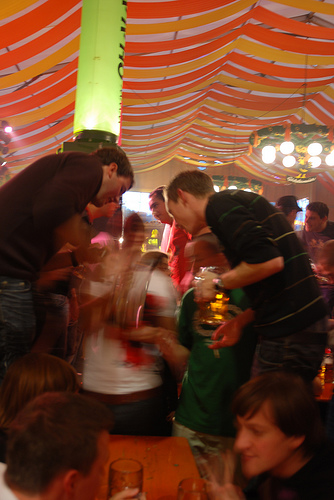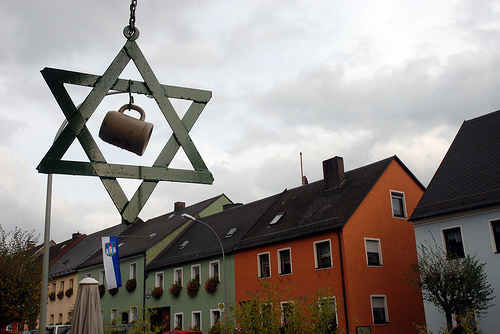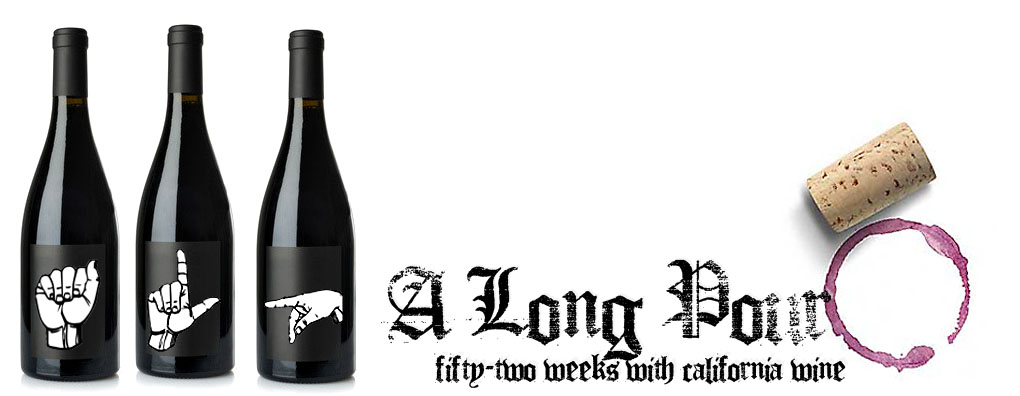Stan Hieronymus – Appellation Beer
When I started A Long Pour, one of my goals was to help bridge gaps in the wine world. Help young beer drinkers see that wine can be just as fun and approachable as beer, and to get snobby wine drinkers to give beer it’s equal place. All of this is arrogant thinking, but that’s OK, I am arrogant. So although I have had little time to do any of that, I really like beer so I wanted to do something with it. One of the blogs that inspired my site was a beer blog called “Appellation Beer”, written by Stan Hieronymus. Stan is in search of “the soul of beer”, in a similar way I am in search of the soul of wine. Stan understands that wine isn’t the only beverage that can claim complexity. In fact, his “about” page states:
Does it matter where beer is brewed?
Yes. At least that’s one of the premises behind Appellation Beer. Some of the others:
– It matters what the ingredients are and where they come from.
– Wines and cheeses aren’t the only products that can claim terroir.
– Beer should be considered in context. That context might be the food it’s served with. That context might be where the beer is enjoyed and the company it is shared with.
Hope that all doesn’t sound pretentious, because another goal of this site is to remain true to a wonderful statement from Anchor Brewing savior Fritz Maytag:
“It’s very hard to get pretentious about beer. You can become knowledgeable and start to talk with a highfalutin’ vocabulary. But you can only go so far with beer, and I’ve always liked that.”
I really like what Stan is doing, so I was excited when he agreed to an interview. So here it is:
 How did you become so interested in beer?
How did you become so interested in beer?
“When I was in college the appeal was what went with beer, including the buzz and hanging out with friends – I never was one to drink alone and beer wasn’t at the table. I wouldn’t have considered it a topic you could write about full time, at least in the United States. When we left our newspaper jobs in 1992 to stitch together a life of travel and freelance writing my wife, Daria Labinsky, pitched a story to American Brewer magazine. She’s an excellent journalist (though these days she’s using her brain as a librarian and archivist) and one story led to another. There were enough stories to keep us both busy, and sometimes we wrote stories together.”
“Long, long ago – when Marc Andreessen was barely out of diapers – I was sports writer. I remember being at a party at a friend’s place in another city and as journalists incessantly do talking about the job. This conversation was with a general assignment reporter who wanted on to be an investigative reporter, to work at a bigger paper, to write “important stories.” He had written about sports before, and was ready to move on from games, but he missed knowing that people cared so much about the topic he was covering.”
“That’s the nice thing about writing about beer. Most people don’t give a shit and move on quickly. But those people who care really care. It’s a broad topic – so writing about not just beer itself, but beer & food and pubs and the business of beer means more sellable stories. A practical consideration. Now that the audience has grown, reflected in the size of “craft beer” sales, it’s possible to focus more on the niches. Those are the stories behind individual beers, the process of brewing, or beers from a region, maybe the brewers themselves.”
“But an important element, ultimately, is the beer must be good. A great back story doesn’t make a beer taste better.”
If you were to make your pitch to convince wine-only drinkers to branch out into beer, what would it be?
“To be honest, I don’t care if wine drinkers decide to try beer or drinkers of industrial lagers decide to explore “craft beer.” Make no mistake, I love talking about beer and can pontificate with the best. I’m happy to share what I know with anybody who wants to listen, but I’m not a recruiter.”
“First we’d talk about what they like and why, individual wines, categories of wines, wine and food. Then I can suggest options, but they/he/she will decide where we’re going. If we’re at my house I might open certain beers. In a bar we might be able to order samples, or at least a variety of beers we could share. There’s something to be said for drinking beer and wine at (almost) the same time, food included. Dinners where a beer and a wine are offered with each course are terrific, except for the part where people are asked to vote for favorites. Enjoying food and drink should not be a competition. Additionally, asking people to vote overlooks that various people taste (and smell) in entirely different ways. I drink a beer with much coriander, for instance, and I get celery and sometimes ham. I’m “used to” intense hops from the American Northwest. You might be on the flip side of both.”
“It comes down to flavor and what you do and don’t like. There’s also a certain joy in the exploration. Right now the “new, new” beers grab a lot of attention. Some of that is merited, but I think exploration should also include the classics, and in them – like in wine – nuance and balance are as important as surprise.”
In wine, much emphasis is put on terroir, or more so in the US, AVA’s. Can you explain what relationship beer has to “place” and how that affects the final outcome of the product?
“In less than 10,000 words? At one end of the spectrum you have the brewing giants. Anheuser-Busch, obviously, has made a fortune by making sure Budweiser made in Newark tastes just like Bud from Houston. Some at SABMiller might tell you that the Pilsner Urquell brewed in Russia tastes the same as the one brewed in Pilsen, its original hometown in the Czech Republic. But not people who taste those beers regularly.”
“In fact, if you drink the beer in the Czech Republic it surely will taste different directly from a can than poured from a bottle, different when you have it pasteurized on tap rather than the unpasteurized version, and even the unpasteurized version versus the unfiltered version you can get at the brewery museum in Pilsen. There are still more differences – some is still fermented in open vats, then aged in wooden barrels and served during the brewery tour. How do place, process, choice of dispense change the beer? Can we break that into percentages? Should we want to?”
“As you can see, I’m full of questions that probably don’t have answers. But here’s the other end of the spectrum. Russian River Brewing in Santa Rosa operates both a brewery and a brewpub. The production brewery has space for more than 400 used (wine) barrels, where a variety of beers are maturing. The brewpub has a much smaller room. Last June brewmaster/owner Vinnie Cilurzo acquired 120 wine barrels that recently held pinot noir from Flowers Vineyard and Winery. He filled them with a brown ale and cherries that with the help of a variety of “wild” yeasts will turn into a beer he calls Supplication. Ten of the barrels are at the brewpub, the rest at the brewery.”
“The beers will be different than those made anywhere else because of a) the base beer, b) the Flowers barrels, c) the blend of yeasts, d) the time they mature (more than a year), e) the choice of cherries and f) the rooms. They will be different than each other because of f).”
“Place happens on many levels.”
Are there California brewers you think are particularly worth watching?
“The American beer revival began in California and the state has more breweries than anywhere else. The list of breweries now making beer at the highest level is very long. Used to be that there was little to be found south of the 35th parallel but now if you make a list of just breweries from the San Diego area you’d probably leave a great one out by accident. That’s why I’m ducking, but will stick to California in the five beers question.”
What advice do you have for an individual who wants to branch out in their understanding of beer?
“Start by reading “Michael Jackson’s Beer Companion.” Almost anything by MJ, who passed away in 2007, will do but this book talks about flavor, history and food in a particularly engaging way.”
“Taste a lot of different beers in a lot of different settings. Take notes. Try a beer, then a glass of wine, then a beer. Repeat. Have a pizza, a plate of cheese, asparagus, some chocolate. Feel free to make it up as you go along. If we’re talking about wine drinkers, your audience, then they’ve been down the path of exploration before. It’s a long road, and that’s a good thing.”
Your top 5 beers worth special effort to try.
“A part of place I maybe didn’t stress enough above is the place where you drink the beer. So three sets of five, the first emphasizing location, some specific and some not. In every case the suggestion is to drink with the locals.”
“- A pale lager in the Czech Republic. We call them pilsners, but the Czechs only call beers from the Pilsen by that name.
– The Bink beers in the courtyard at Brouwerij Kerkom in the Belgian countryside south of Saint Truden (located east of Brussels). The courtyard is located within the whitewashed walls of an old farmhouse. Of course it’s best to allow about three months for the rest of Belgium.
– A well-cared for cask-conditioned bitter in an English country pub.
– Spotted Cow, from New Glarus Brewing, at Puempel’s Olde Tavern in New Glarus, Wisconsin. The beer is not fancy and you are free to move on to more exotic choices but it’s a beer from a great brewery in fine tavern in a wonderful small town.
– Anything “indigenous” from a medium size or smaller brewery in Bavaria. A weiss beer, a helles, a dunkel, a bock in season, and so on. For instance, the unfiltered pilsner from Private Landbrauerei Schönram in Petting/Schönram (not far from Salzburg, Austria) packs as much flavor as any so-called “imperial” pilsner. You can only get it unfiltered at the restaurant on the brewery property. The best-selling beer is a helles (the most popular style in the region) and it has a ton of flavor. But the stunner is the light version of helles at 3.5 percent – unlike any light beer you’ll find in the U.S.
– A Zoigl beer in Neuhaus. Zoigl beers, unique to the Oberflaz region of Bavaria located between Bamberg and the Czech border, come from a community brewhouse. The right to take beer home to complete fermentation and lagering belongs to individuals living in particular houses with brewing rights. They serve those beers in a pub that’s part of the house, most operating one weekend a month. When a pub is open the owner hangs a sign – a Brauerstern (Brewer’s Star) – outside the door, Zoigl meaning sign in the local dialect.”
“Oops. That’s six.”
“5 relatively easy to find California beers
Anchor Steam
Sierra Nevada Pale Ale
Stone IPA
The Bruery Orchard White
North Coast Old Rasputin Russian Imperial Stout’
“5 California beers worth the extra effort
Port/Lost Abbey Cuvee de Tomme
Russian River Temptation
Moonlight Death and Taxes Black
Firestone Walker XIII
Hollister Hip Hop Double IPA”
Stan, keep you mug full and your bottles in the appropriate location that bottles should be stored.
Check out the blog: “Appellation Beer – In Search of the Soul of Beer”
Stan sent me the pictures above. The first is Oktoberfest in Stuttgart Germany. The second is a Zoigl star.


